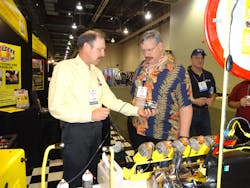When Evaporative Emission System (EVAP) codes come in on 2000 to 2004 Toyotas, the first thing the tech should do after a visual inspection and checking for diagnostic trouble codes (DTCs) is to verify if there is a leak present in the vehicle at the time of test; this is accomplished by performing a leak test.
If there is a leak in the system, deciding what tests to begin with would depend on what equipment the tech is using. If a smoke machine is used, the technician would connect the smoke machine and close the EVAP vent solenoid.
Then the tech turns on the smoke machine and looks for smoke. It is important to understand that very little to no smoke comes out leak sizes less than .020 of an inch.
Additionally, if the smoke machine has a flow indicator, it will need to show no flow. The ball in the flow indicator must be at the bottom. If the ball is not at the bottom of the flow indicator, a leak is present.
In the case of leaks less than .020 of an inch, the ball will not be at the bottom of the indicator. However, very little to no smoke will come out these small leak sites. This makes it difficult to find small leaks in EVAP systems.
If the system being tested has a bypass valve, the DTC will indicate which side of the EVAP system the leak is on. To manually accomplish this, the hose from the carbon canister to the fuel tank is disconnected and plugged. Then check to see if the ball in the flow indicator is seated.
If there is no smoke, this does not mean there is no leak. Thermal changes can make a leak come and go. Additionally, sensor failures can cause leak DTCs which are not present to be set.
One of the biggest problems occurs when technicians assume these machines will find small leaks as well as large ones. This is a problem if you believe the machine can find the leak and you smoke the system but no smoke is emitted from the system and you conclude there is not a leak present. However, if there is a leak present, the vehicle will come back, causing a loss of confidence from the customer, and a loss of revenue for the shop.
If the tech is using the Bullseye Leak Detector from ATS, the tech would close the EVAP vent solenoid and charge the system with CO2. The low pressure gauge does a flow test as the charge is put into the system.
The flow gauge is divided into colors that show the size of the leak in the system. If the gauge needle is in the green, it indicates there is no leak at this time; if the needle is in the yellow, you have a leak that is approximately .005-.015 in leak size; if the needle is in the light orange, you have a leak that is approximately .015-.025 in leak size; if the needle is in the orange, you have a leak that is approximately .025-.040 in leak size; if the needle is in the red, you have a leak that is greater than .040 in leak size.
If the gauge indicates a leak is present, the CO2 is shut off. Now the gauge becomes a very accurate leak down indicator and will show the decay rate of the system. This is read as how many inches of water column is lost over time.
If the decay rate loses more than one inch of water column in one minute, there is a leak present that will set a DTC, and will need to be repaired. Once the tech knows what size the leak is, they will take the leak detector and go around the fuel containment and handling system.
When the detector goes off, the leak site area will be known. Then the tech will spray the area in question with leak seeker solution to find the exact location of the leak site. The Bullseye Leak Detector will find less than a .001 inch hole with only 14 inches of water column pressurizing the system.
(Editor's Note: Bernie Thompson, president of Automotive Test Solutions (ATS), recently offered some tips on how technicians can address Evaporative Emission System (EVAP) codes in 2000 to 2004 Toyotas.)


